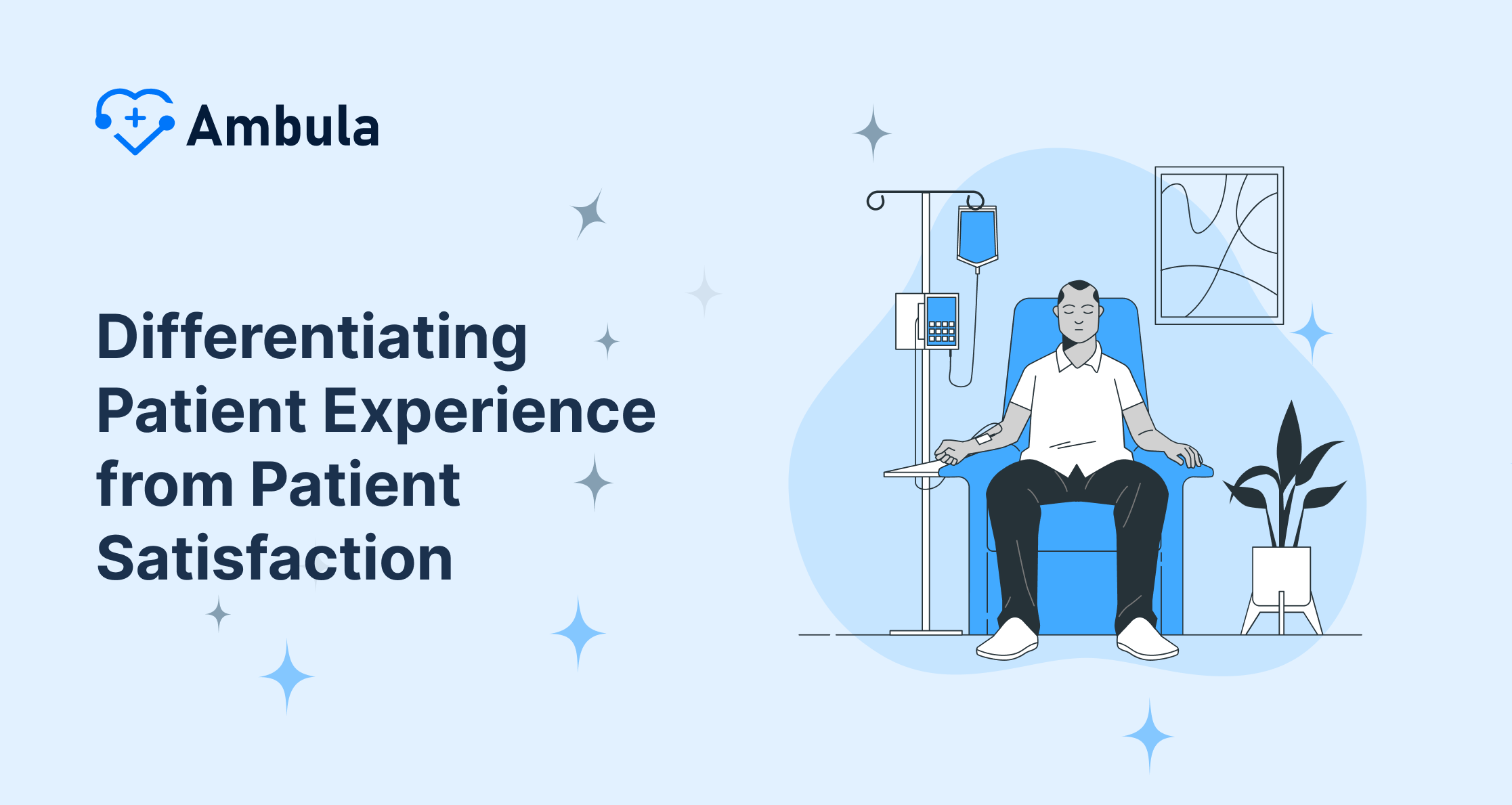In today’s healthcare landscape, the concept of patient experience extends far beyond mere patient satisfaction. It encompasses the entirety of interactions and touchpoints a patient has with the healthcare ecosystem, from scheduling appointments and engaging with healthcare providers to navigating facilities and accessing post-care support. This multifaceted journey shapes a patient’s perceptions, emotions, and overall impressions of the care they receive.
At its core, patient experience is a culmination of four interconnected elements:
- Interactions: Every encounter, whether in-person or virtual, shapes the patient experience. This includes interactions with healthcare professionals, administrative staff, and the physical environment itself.
- Culture: The vision, values, and community ethos of a healthcare facility profoundly influence the patient experience. A culture that prioritizes empathy, respect, and patient-centricity fosters a positive atmosphere.
- Perceptions: Patient experience is ultimately defined by how individuals perceive and internalize their healthcare journey. These perceptions are shaped by expectations, communication, and the overall quality of care received.
- Continuum of Care: The patient experience extends beyond the walls of a healthcare facility, encompassing pre-care preparations, the care delivery process itself, and post-care follow-up and support.
By understanding and addressing these interconnected elements, healthcare organizations can cultivate a truly exceptional patient experience, one that transcends mere satisfaction and fosters a sense of trust, confidence, and overall well-being.
Distinguishing Patient Experience from Patient Satisfaction
While patient experience and patient satisfaction are often used interchangeably, they represent distinct yet interrelated concepts. Patient satisfaction is a subjective measure that evaluates whether a patient’s expectations were met during their healthcare encounter. It is a reactive assessment based on individual perceptions and preconceived notions.
In contrast, patient experience is a more objective and comprehensive evaluation of the actual events, interactions, and processes that occur throughout the patient’s healthcare journey. It is an assessment of whether critical elements of care, such as clear communication, timely access, and respectful treatment, were consistently delivered.
To illustrate this distinction, consider two patients receiving identical medical treatment. If one patient had higher expectations or preconceived notions about the care delivery process, they may rate their satisfaction lower than the other patient, despite receiving the same level of care. Patient experience, however, would objectively evaluate the quality of care provided, regardless of individual expectations.
By focusing on patient experience, healthcare organizations can proactively identify areas for improvement, streamline processes, and enhance the overall quality of care, ultimately leading to increased patient satisfaction as a byproduct.
The Profound Impact of Exceptional Patient Experience
Investing in a superior patient experience yields numerous benefits that reverberate throughout the healthcare ecosystem. These advantages extend beyond simply enhancing patient satisfaction and encompass improved clinical outcomes, operational efficiencies, and long-term organizational success.
Improved Patient Outcomes and Adherence
Numerous studies have consistently demonstrated a positive correlation between exceptional patient experience and improved health outcomes. When patients feel heard, respected, and actively involved in their care, they are more likely to adhere to treatment plans, follow through with recommended follow-up appointments, and actively participate in their own health management.
A seminal study published in the New England Journal of Medicine [1] found that patients who reported better communication and overall experience with their healthcare providers exhibited better blood sugar control and fewer functional limitations when managing chronic conditions like diabetes.
Furthermore, a meta-analysis conducted by the Beryl Institute [2] revealed a direct link between positive patient experience and enhanced healthcare outcomes, even during the challenging circumstances of the COVID-19 pandemic.
Increased Revenue and Profitability
In addition to its clinical benefits, a focus on patient experience can significantly impact an organization’s financial performance. Research by Press Ganey [3] indicates that patients are five times more likely to select a healthcare provider based on a positive patient experience than on consumer marketing efforts alone.
Moreover, hospitals with exceptional patient experience ratings tend to have substantially higher profit margins compared to their counterparts. A Deloitte study [4] found that hospitals with excellent patient experience scores enjoyed an average net margin of 4.7%, while those with low scores averaged only 1.8%.
This financial advantage can be attributed to increased patient loyalty, reduced medical malpractice risk, and operational efficiencies resulting from streamlined processes and improved staff satisfaction.
Enhanced Reputation and Competitive Advantage
In today’s digital age, a healthcare organization’s reputation is heavily influenced by online reviews and word-of-mouth testimonials. A staggering 90% of patients consult online review platforms [5] before selecting a healthcare provider, underscoring the importance of cultivating a positive patient experience.
Furthermore, patients are increasingly willing to switch providers in pursuit of exceptional customer service. According to an Accenture report [6], 51% of patients would consider changing healthcare providers to receive superior customer service, highlighting the competitive advantage that a focus on patient experience can provide.
By prioritizing patient experience, healthcare organizations can differentiate themselves in a crowded marketplace, attract and retain patients, and foster a positive reputation that resonates across their communities.
Actionable Strategies for Enhancing Patient Experience
Elevating patient experience requires a multifaceted approach that encompasses every touchpoint of the patient journey. By implementing the following strategies, healthcare organizations can create a seamless, patient-centric experience that fosters trust, loyalty, and overall satisfaction.
1. Optimize Digital Touchpoints
In the digital age, patient experience begins long before an individual sets foot in a healthcare facility. A robust online presence, user-friendly website, and seamless digital tools can significantly enhance the patient journey from the outset.
- Website Optimization: Ensure that your organization’s website serves as a comprehensive digital hub, providing accurate and up-to-date information about services, facilities, and healthcare professionals. Incorporate high-resolution images, virtual tours, and testimonials to create a welcoming and transparent online experience.
- Online Appointment Scheduling: Empower patients with the convenience of scheduling appointments online through a user-friendly portal. This not only streamlines the process but also caters to the growing preference for digital self-service tools.
- Digital Communication Channels: Implement secure and HIPAA-compliant communication channels, such as text messaging and email, to facilitate seamless communication between patients and healthcare providers. This enables timely appointment reminders, follow-up instructions, and prompt responses to patient inquiries.
- Telehealth Integration: Embrace telehealth solutions to provide patients with convenient access to virtual consultations, follow-up appointments, and remote monitoring services. This not only enhances the patient experience but also expands access to care for individuals with mobility challenges or those residing in underserved areas.
2. Streamline Administrative Processes
Administrative processes can significantly impact patient experience, particularly during the initial stages of the healthcare journey. By optimizing these processes, healthcare organizations can reduce frustrations, minimize wait times, and create a more seamless experience for patients.
- Digital Registration and Paperwork: Offer patients the option to complete registration forms, medical histories, and consent documents digitally, either online or through a secure patient portal. This not only saves time but also demonstrates respect for patients’ convenience.
- Efficient Check-In and Check-Out: Implement user-friendly check-in and check-out systems, such as self-service kiosks or mobile check-in options, to minimize wait times and streamline the administrative process.
- Automated Appointment Reminders: Utilize automated appointment reminder systems, leveraging text messages, email, or automated phone calls, to reduce no-shows and ensure patients are well-prepared for their appointments.
- Transparent Billing and Payment Options: Provide clear and transparent billing information, along with convenient payment options, such as online bill pay or mobile payment platforms. This not only enhances the patient experience but also improves financial performance and reduces administrative burdens.
3. Cultivate a Patient-Centric Culture
A patient-centric culture is the foundation upon which exceptional patient experience is built. By fostering an environment that prioritizes empathy, respect, and open communication, healthcare organizations can create a lasting positive impact on patient perceptions and overall satisfaction.
- Staff Training and Development: Invest in comprehensive training programs that equip healthcare professionals and support staff with the skills necessary to deliver compassionate, patient-centric care. This includes effective communication techniques, active listening, and cultural competency training.
- Empowerment and Autonomy: Empower healthcare professionals to exercise autonomy and make decisions that prioritize patient needs and preferences. This fosters a sense of ownership and accountability in delivering exceptional patient experiences.
- Collaborative Care Approach: Encourage a collaborative approach to care, where patients are actively involved in decision-making processes and their preferences are respected. This not only enhances patient engagement but also promotes better adherence to treatment plans.
- Continuous Improvement Mindset: Embrace a culture of continuous improvement by regularly soliciting patient feedback, analyzing data, and implementing evidence-based strategies to address identified areas for enhancement.
4. Optimize Facility Design and Amenities
The physical environment in which healthcare is delivered can profoundly impact patient experience. By designing facilities with patient comfort and convenience in mind, healthcare organizations can create a welcoming and healing atmosphere that fosters positive perceptions and overall satisfaction.
- Comfortable and Accessible Spaces: Prioritize the design of comfortable and accessible waiting areas, examination rooms, and patient rooms. Incorporate elements such as natural lighting, soothing color schemes, and comfortable seating to create a calming and inviting environment.
- Wayfinding and Signage: Implement clear and intuitive wayfinding systems, including well-designed signage and visual cues, to help patients navigate facilities with ease and minimize frustration.
- Amenities and Hospitality Services: Consider offering amenities such as complimentary Wi-Fi, refreshments, and comfortable lounges to enhance the overall patient experience, particularly during extended visits or wait times.
- Accessible Parking and Transportation: Ensure that parking facilities are conveniently located, well-lit, and accessible for patients with mobility challenges. Additionally, consider partnering with transportation services or offering shuttle services to facilitate easy access to the healthcare facility.
5. Leverage Technology and Data Analytics
Technology and data analytics play a crucial role in enhancing patient experience by enabling personalized care, streamlining processes, and identifying areas for improvement.
- Patient Portals and Mobile Apps: Implement secure and user-friendly patient portals and mobile applications that enable patients to access their medical records, communicate with healthcare providers, schedule appointments, and receive personalized health reminders and educational resources.
- Telehealth and Remote Monitoring: Leverage telehealth solutions and remote monitoring technologies to provide patients with convenient access to care, particularly for those with chronic conditions or mobility challenges.
- Data Analytics and Predictive Modeling: Utilize data analytics and predictive modeling techniques to gain insights into patient preferences, identify potential bottlenecks or areas for improvement, and develop targeted strategies to enhance the patient experience.
- Artificial Intelligence and Chatbots: Explore the use of artificial intelligence and chatbots to provide patients with 24/7 access to basic information, appointment scheduling, and triage services while also reducing administrative burdens on healthcare staff.
6. Continuously Solicit and Respond to Patient Feedback
Actively seeking and responding to patient feedback is crucial for identifying areas for improvement and fostering a culture of continuous enhancement. By implementing robust feedback mechanisms and demonstrating a commitment to addressing patient concerns, healthcare organizations can build trust, loyalty, and long-term patient satisfaction.
- Patient Satisfaction Surveys: Implement comprehensive patient satisfaction surveys that capture feedback across various touchpoints of the patient journey, including pre-visit, during the visit, and post-visit experiences.
- Multiple Feedback Channels: Offer patients a variety of feedback channels, such as online surveys, mobile apps, comment cards, or dedicated feedback hotlines, to ensure that every patient has the opportunity to share their experiences.
- Timely and Personalized Responses: Establish protocols for promptly responding to patient feedback, addressing concerns, and acknowledging positive experiences. Personalized responses can go a long way in building trust and demonstrating a commitment to patient-centricity.
- Closed-Loop Feedback Systems: Implement closed-loop feedback systems that ensure patient concerns and suggestions are systematically reviewed, addressed, and communicated back to patients, fostering a sense of transparency and accountability.
- Patient Advisory Councils: Consider establishing patient advisory councils or focus groups to gain valuable insights directly from patients and their families. This collaborative approach can inform strategic decisions and drive continuous improvement efforts.
Careers in Patient Experience: Driving Positive Change
As the healthcare industry continues to evolve and patient expectations rise, the demand for professionals dedicated to enhancing patient experience is rapidly increasing. One such role is that of a patient experience manager, a position that plays a pivotal role in shaping and optimizing the patient journey.
Patient experience managers are responsible for developing and implementing strategies that prioritize patient-centricity, streamline processes, and foster a culture of exceptional service delivery. They collaborate closely with healthcare professionals, administrative staff, and leadership teams to identify areas for improvement, analyze patient feedback, and implement evidence-based solutions.
To pursue a career as a patient experience manager, individuals typically require a strong foundation in healthcare administration or a related field. A Bachelor’s degree in Health Services Coordination, a Master’s degree in Health Leadership, or an MBA in Healthcare Management can provide the necessary knowledge and skills to excel in this role.
At the heart of a patient experience manager’s responsibilities lies a deep commitment to advocating for patients and ensuring their voices are heard. They must possess exceptional communication skills, empathy, and a keen understanding of the complexities of the healthcare system. Additionally, proficiency in data analysis, project management, and change management is essential for driving continuous improvement initiatives.
By pursuing a career in patient experience, individuals have the opportunity to make a lasting impact on the quality of care delivered, foster trust and loyalty within the healthcare community, and ultimately contribute to better health outcomes for patients.
Ambula: Empowering Patient-Centric Care with Innovative EMR Solutions
At Ambula, we understand the paramount importance of exceptional patient experience in delivering high-quality, patient-centric care. Our cutting-edge electronic medical record (EMR) software is designed to streamline healthcare processes, enhance communication, and empower healthcare professionals to focus on what matters most: providing exceptional care to their patients.
Our EMR solution offers a comprehensive suite of features that directly contribute to an elevated patient experience:
- Seamless Patient Engagement: Ambula’s patient portal enables patients to access their medical records, communicate with their healthcare providers, schedule appointments, and receive personalized health reminders and educational resources, fostering a sense of empowerment and active involvement in their care journey.
- Efficient Documentation and Workflow: Our intuitive EMR interface and customizable templates enable healthcare professionals to efficiently document patient encounters, streamlining administrative tasks and reducing the burden of paperwork, ultimately allowing for more time dedicated to direct patient care.
- Integrated Telehealth Capabilities: Ambula’s telehealth platform seamlessly integrates with our EMR solution, enabling healthcare providers to conduct virtual consultations, follow-up appointments, and remote monitoring, enhancing patient access to care and convenience.
- Robust Data Analytics and Reporting: Our advanced data analytics and reporting capabilities provide valuable insights into patient preferences, trends, and areas for improvement, empowering healthcare organizations to make data-driven decisions and continuously optimize the patient experience.
- Dedicated Support and Training: At Ambula, we understand that technology is only as effective as its adoption and utilization. Our team of experts provides comprehensive training and ongoing support to ensure healthcare professionals can leverage the full potential of our EMR solution, enhancing their ability to deliver exceptional patient-centric care.
By partnering with Ambula, healthcare organizations can unlock the power of innovative technology to elevate patient experience, streamline operations, and ultimately drive better health outcomes for the communities they serve.
For more information about our EMR solutions and how we can support your organization’s patient experience initiatives, please visit our website at www.ambulaa.com or contact our dedicated support team for personalized assistance.
Sources:
[1] Fremont, A. M., Cleary, P. D., Hargraves, J. L., Rimer, B. K., & Jacobson, N. H. (1999). Patient-centered processes of care and long-term outcomes of myocardial infarction. Journal of General Internal Medicine, 14(8), 512-517. https://link.springer.com/article/10.1046/j.1525-1497.1999.08100.x
[2] Beryl Institute. (2020). The State of Patient Experience 2020: A Global Perspective on How Patient Experience is Impacting Healthcare. https://www.theberylinstitute.org/page/PXBENCHMARKING
[3] Press Ganey. (2018). The Rising Importance of Patient Experience. https://www.pressganey.com/resources/white-papers/the-rising-importance-of-patient-experience
[4] Deloitte. (2016). The Value of Patient Experience: Hospitals with Better Patient-Reported Experience Perform Better Financially. https://www2.deloitte .com/us/en/pages/life-sciences-and-health-care/articles/hospitals-patient-experience.html
[5] Doctor.com. (2020). Healthcare Consumer Insight & Digital Engagement Survey. https://www.doctor.com/resources/healthcare-consumer-insight-digital-engagement-survey/
[6] Accenture. (2019). Digital Health Consumer Survey. https://www.accenture.com/us-en/insights/health/accenture-digital-health-consumer-survey-2019
Engagement and Loyalty
Fostering exceptional patient experience is not merely a noble pursuit; it is a strategic imperative for healthcare organizations seeking to cultivate long-term patient engagement and loyalty. In an increasingly competitive landscape, patients have more choices than ever before, and their loyalty is contingent upon the quality of their experiences.
Research by the Beryl Institute [7] reveals that patients who report positive experiences are more likely to adhere to treatment plans, follow through with recommended care, and actively participate in their own health management. This increased engagement not only contributes to better health outcomes but also strengthens the patient-provider relationship, fostering trust and loyalty over time.
Furthermore, a study by Press Ganey [8] found that patients who had exceptional experiences were three times more likely to remain with their healthcare provider compared to those who had poor experiences. This retention rate has significant implications for an organization’s financial performance, as acquiring new patients is typically more costly than retaining existing ones.
By prioritizing patient experience, healthcare organizations can create a virtuous cycle of engagement, loyalty, and positive word-of-mouth referrals, ultimately driving sustainable growth and success.
Addressing Challenges and Overcoming Barriers
While the benefits of exceptional patient experience are clear, healthcare organizations often face various challenges and barriers in their pursuit of this goal. Addressing these obstacles proactively is crucial for successful implementation and long-term sustainability of patient experience initiatives.
Resource Constraints
One of the most significant challenges faced by healthcare organizations is the allocation of limited resources, including financial constraints, staffing limitations, and competing priorities. Implementing patient experience initiatives may require upfront investments in technology, staff training, and facility upgrades, which can strain already tight budgets.
To overcome this challenge, healthcare organizations should adopt a strategic approach to resource allocation, prioritizing initiatives that yield the greatest return on investment. This may involve conducting cost-benefit analyses, exploring partnerships or collaborations, and leveraging existing resources more effectively.
Additionally, organizations should consider the long-term benefits of patient experience initiatives, such as increased patient loyalty, reduced medical malpractice risk, and improved operational efficiencies, which can ultimately lead to cost savings and revenue growth.
Cultural Resistance and Change Management
Implementing patient experience initiatives often requires significant cultural shifts within healthcare organizations. Overcoming resistance to change and fostering a patient-centric mindset among healthcare professionals and support staff can be a formidable challenge.
Effective change management strategies are essential to address this barrier. This may involve clear communication of the vision and benefits of patient experience initiatives, active engagement of stakeholders throughout the process, and ongoing training and development programs to reinforce the importance of patient-centricity.
Healthcare organizations should also consider involving patients and their families in the change process, leveraging their perspectives and insights to shape the patient experience strategy. This collaborative approach can foster a sense of ownership and buy-in among healthcare professionals, ultimately driving successful cultural transformation.
Data Integration and Analytics
Effective patient experience initiatives rely heavily on data-driven insights and analytics. However, many healthcare organizations struggle with siloed data systems, inconsistent data collection methods, and limited analytical capabilities, hindering their ability to make informed decisions.
Addressing this challenge requires a comprehensive approach to data integration and analytics. Healthcare organizations should invest in robust data management systems that enable seamless integration of patient data from various sources, such as electronic medical records (EMRs), patient portals, and satisfaction surveys.
Additionally, organizations should leverage advanced analytics tools and techniques, such as predictive modeling and machine learning, to gain deeper insights into patient preferences, identify patterns and trends, and develop targeted strategies for enhancing the patient experience.
Collaboration with data analytics experts, either through internal resources or external partnerships, can be invaluable in unlocking the full potential of data-driven patient experience initiatives.
Regulatory Compliance and Privacy Concerns
Healthcare organizations must navigate a complex landscape of regulatory requirements and privacy concerns when implementing patient experience initiatives, particularly those involving digital technologies and data collection.
Ensuring compliance with regulations such as the Health Insurance Portability and Accountability Act (HIPAA) and the General Data Protection Regulation (GDPR) is crucial to protect patient privacy and maintain trust. Healthcare organizations should invest in robust cybersecurity measures, implement strict data governance policies, and provide comprehensive training to staff on privacy and data protection best practices.
Additionally, healthcare organizations should be transparent about their data collection and usage practices, clearly communicating with patients about how their information will be used and offering opt-out options when appropriate.
By proactively addressing privacy concerns and demonstrating a commitment to ethical data handling, healthcare organizations can alleviate patient concerns and foster a sense of trust, ultimately enhancing the overall patient experience.
Conclusion: Embracing Patient-Centricity for a Healthier Future
In the ever-evolving healthcare landscape, patient experience has emerged as a critical differentiator and a driving force behind better health outcomes, increased patient loyalty, and long-term organizational success. By embracing a patient-centric approach and implementing strategies that prioritize exceptional patient experiences, healthcare organizations can not only meet but exceed the rising expectations of today’s healthcare consumers.
The benefits of exceptional patient experience extend far beyond mere satisfaction; they encompass improved clinical outcomes, enhanced operational efficiencies, and a competitive advantage in an increasingly crowded marketplace. As healthcare organizations strive to deliver value-based care and foster sustainable growth, investing in patient experience initiatives is no longer an option but a necessity.
By optimizing digital touchpoints, streamlining administrative processes, cultivating a patient-centric culture, designing welcoming facilities, leveraging technology and data analytics, and continuously soliciting and responding to patient feedback, healthcare organizations can create a seamless and personalized journey for their patients.
Moreover, the demand for professionals dedicated to enhancing patient experience, such as patient experience managers, continues to grow, presenting exciting career opportunities for those passionate about driving positive change in the healthcare industry.
As we look towards a future where healthcare is increasingly patient-centric, it is imperative that organizations embrace a holistic approach to patient experience, one that encompasses every touchpoint of the patient journey and fosters a culture of empathy, respect, and continuous improvement.
By prioritizing patient experience, healthcare organizations can not only improve the lives of the individuals they serve but also contribute to the overall well-being of their communities, creating a lasting legacy of exceptional care and unwavering commitment to patient-centricity.
Sources:
[7] Beryl Institute. (2021). The State of Patient Experience 2021: A Global Perspective on Elevating the Human Experience in Healthcare. https://www.theberylinstitute.org/page/PXBENCHMARKING2021
[8] Press Ganey. (2018). The Rising Importance of Patient Experience. https://www.pressganey.com/resources/white-papers/the-rising-importance-of-patient-experience






